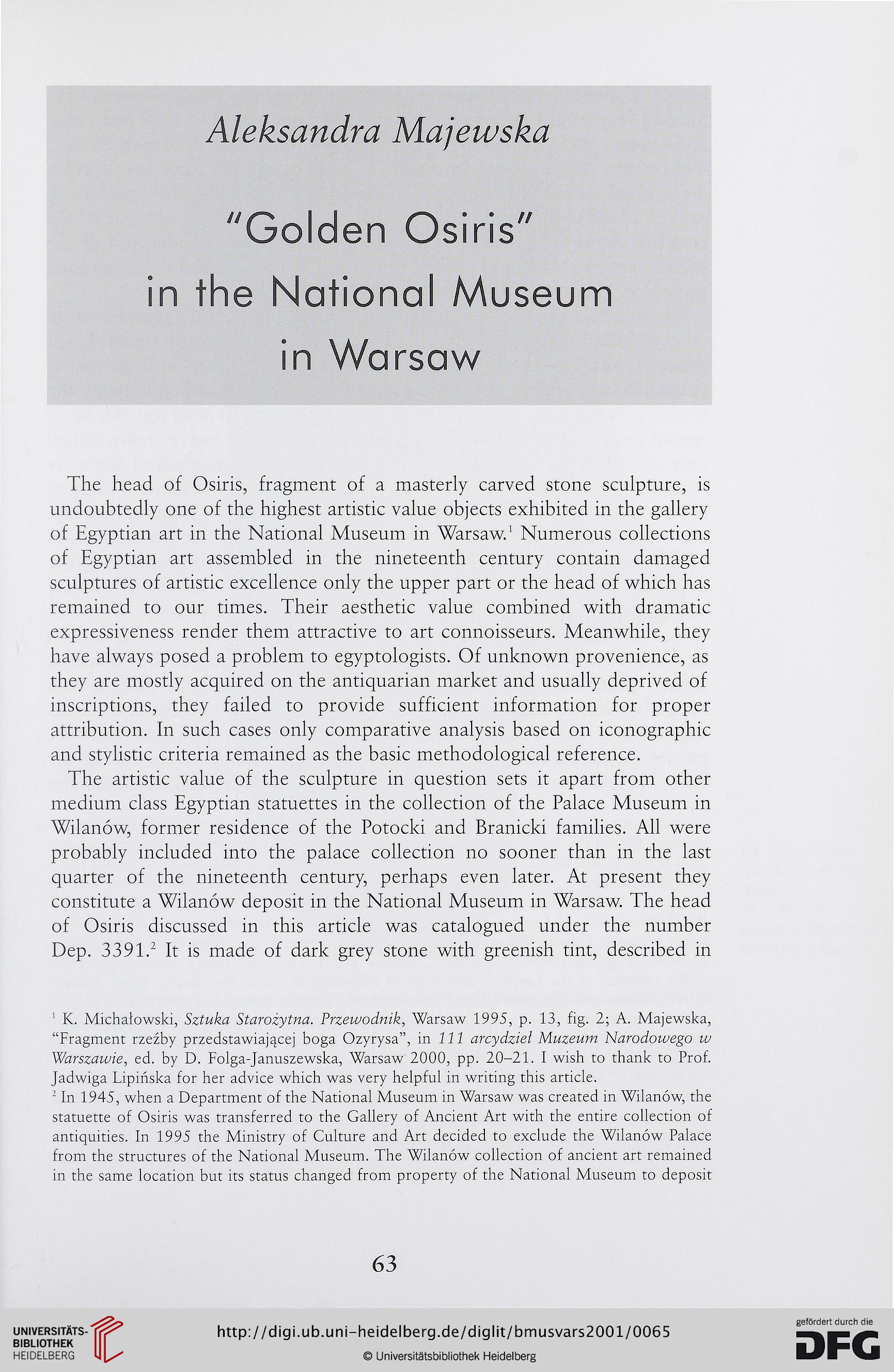Aleksandra Majewska
"Golden Osiris"
in the National Museum
in Warsa w
The head of Osiris, fragment of a masterly carved stone sculpture, is
undoubtedly one of the highest artistic value objects exhibited in the gallery
of Egyptian art in the National Museum in Warsaw.1 Numerous collections
of Egyptian art assembled in the nineteenth century contain damaged
sculptures of artistic excellence only the upper part or the head of which has
remained to our times. Their aesthetic value combined with dramatic
expressiveness render them attractive to art connoisseurs. Meanwhile, they
have always posed a problem to egyptologists. Of unknown provenience, as
they are mostly acąuired on the antiąuarian market and usually deprived of
inscriptions, they failed to provide sufficient information for proper
attribution. In such cases only comparative analysis based on iconographic
and stylistic criteria remained as the basie methodological reference.
The artistic value of the sculpture in ąuestion sets it apart from other
medium class Egyptian statuettes in the collection of the Pałace Museum in
Wilanów, former residence of the Potocki and Branicki families. Ali were
probably included into the pałace collection no sooner than in the last
ąuarter of the nineteenth century, perhaps even later. At present they
constitute a Wilanów deposit in the National Museum in Warsaw. The head
of Osiris discussed in this article was catalogued under the number
Dep. 3391.2 It is madę of dark grey stone with greenish tint, described in
1 K. Michałowski, Sztuka Starożytna. Przewodnik, Warsaw 1995, p. 13, fig. 2; A. Majewska,
“Fragment rzeźby przedstawiającej boga Ozyrysa”, in 111 arcydzieł Muzeum Narodowego w
Warszawie, ed. by D. Folga-Januszewska, Warsaw 2000, pp. 20-21. I wish to thank to Prof.
Jadwiga Lipińska for her advice which was very helpful in writing this article.
2 In 1945, when a Department of the National Museum in Warsaw was created in Wilanów, the
statuette of Osiris was transferred to the Gallery of Ancient Art with the entire collection of
antiąuities. In 1995 the Ministry of Culture and Art decided to exclude the Wilanów Pałace
from the structures of the National Museum. The Wilanów collection of ancient art remained
in the same location but its status changed from property of the National Museum to deposit
63
"Golden Osiris"
in the National Museum
in Warsa w
The head of Osiris, fragment of a masterly carved stone sculpture, is
undoubtedly one of the highest artistic value objects exhibited in the gallery
of Egyptian art in the National Museum in Warsaw.1 Numerous collections
of Egyptian art assembled in the nineteenth century contain damaged
sculptures of artistic excellence only the upper part or the head of which has
remained to our times. Their aesthetic value combined with dramatic
expressiveness render them attractive to art connoisseurs. Meanwhile, they
have always posed a problem to egyptologists. Of unknown provenience, as
they are mostly acąuired on the antiąuarian market and usually deprived of
inscriptions, they failed to provide sufficient information for proper
attribution. In such cases only comparative analysis based on iconographic
and stylistic criteria remained as the basie methodological reference.
The artistic value of the sculpture in ąuestion sets it apart from other
medium class Egyptian statuettes in the collection of the Pałace Museum in
Wilanów, former residence of the Potocki and Branicki families. Ali were
probably included into the pałace collection no sooner than in the last
ąuarter of the nineteenth century, perhaps even later. At present they
constitute a Wilanów deposit in the National Museum in Warsaw. The head
of Osiris discussed in this article was catalogued under the number
Dep. 3391.2 It is madę of dark grey stone with greenish tint, described in
1 K. Michałowski, Sztuka Starożytna. Przewodnik, Warsaw 1995, p. 13, fig. 2; A. Majewska,
“Fragment rzeźby przedstawiającej boga Ozyrysa”, in 111 arcydzieł Muzeum Narodowego w
Warszawie, ed. by D. Folga-Januszewska, Warsaw 2000, pp. 20-21. I wish to thank to Prof.
Jadwiga Lipińska for her advice which was very helpful in writing this article.
2 In 1945, when a Department of the National Museum in Warsaw was created in Wilanów, the
statuette of Osiris was transferred to the Gallery of Ancient Art with the entire collection of
antiąuities. In 1995 the Ministry of Culture and Art decided to exclude the Wilanów Pałace
from the structures of the National Museum. The Wilanów collection of ancient art remained
in the same location but its status changed from property of the National Museum to deposit
63




